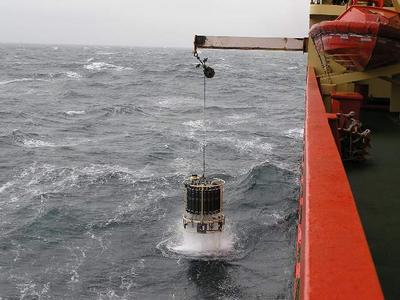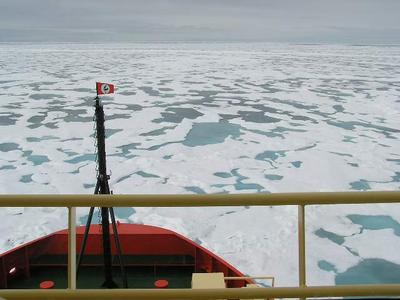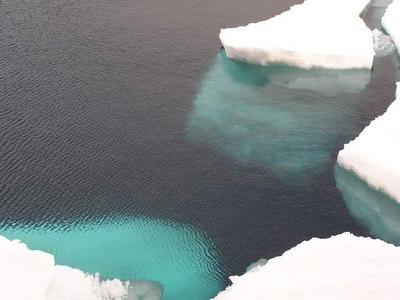20 August, 2003
In the history of Arctic exploration, one pioneer stands above all
others in creativity, intellect, and sheer daring: Fridtjof Nansen.
A distinguished scientist considered being one of the founders of
oceanography; he set out in 1893 to demonstrate the existence of a
trans-polar current in the Arctic Ocean. Nansen's plan to
intentionally beset his ship, the Fram, into the ice and drift across
the North Pole was spectacular, if not reckless. After two years
drifting in the ice, Nansen's restlessness got the best of him. He
decided contrary to his original theory that his ship would not pass
over the pole, so he and another shipmate set out on skis. His
journey "farthest north" (86 degrees of latitude) is forever etched
into the annals of heroic adventure and scientific discovery.
Although Nansen's brave exploits often eclipsed his scholarship to
the public, scientists will always remember him for his contributions
to science and history. From his soundings of the ocean bottom while
he drifted on the Fram, Nansen discovered the deep water of the
Arctic Basin which had previously been thought to be relatively
shallow. He also first described what later became known as the
Ekman spiral, named for the mathematician that quantified Nansen's
observed deviation in the layers of seawater due to the earth's
rotation. Later he explained the "dead water" phenomenon (i.e.
standing waves where fresh water lies on top of salt water) that was
first described in Roman times. And Nansen was an inventor too. He
developed a reversible bottle for taking deep seawater samples which
was later modified by Otto Petterson. Now known as the
Nansen-Petterson water bottle, it was used by oceanographers around
the world until very recently. He went on to investigate the
variable currents of the Gulf Stream. Finally, Nansen's work The
Norwegian Sea was the first comprehensive treatise of any sea, and
his book Northern Mists remains required reading for students of
Arctic exploration history.
So in this spirit of scientific adventure, it's not much of a stretch
to put the scientists and technicians aboard the research vessel
Nathaniel B. Palmer in the same boat with Nansen. For starters, the
Arctic Ocean is probably the least known region on the planet. (The
Antarctic continent by contrast has a permanently-based group of
scientists working at the South Pole Station.) And it is modern day
explorer-scientists like Dr. Jim Swift that are hard at work in
probing its secrets. Sure, even though the Palmer is a far cry from
the Fram, and the Chief Scientist's room is somewhat more comfortable
than Nansen's cabin, the general purpose of each cruise hasn't
changed; that is, making the unknown known.
The methods and technology used by today's oceanographers are
different, of course, but the scientific exploration of the Arctic
continues onward in much the same manner as in Nansen's day. The
discovery of the westward flowing current during the cruise's last
cast, for example, may not be unlike Nansen's Ekman spiral which
represented a new contribution to the field of fluid dynamics. Could
this west flowing river in the sea be a major new mechanism for
moving waters from the continental slope en masse into the basin
interior? Maybe the answer will reveal itself in what Jim Swift
calls an "aha" moment. That's when the light bulb turns-on in the
mind's eye and the key to understanding some phenomena becomes
crystal-clear. Jim had one of those aha moments while working on his
PhD dissertation in the same (or at least nearby) waters that Nansen
had previously studied. All of a sudden, as he looked at the data
that he had studied many times before, he recognized the existence of
a new current that had been overlooked by earlier expeditions (that
is if I remember the story correctly). Jim considers himself
fortunate to have experienced at least one of those bright flashes of
insight at least once during his career, but knowing Jim, I bet it
happens again.
And so it goes. Slowly but surely, cruise by cruise, station by
station, sample by sample, the Arctic Ocean will reveal its secrets
to the oceanographers probing its depths for as Jim Swift
appropriately remarked, "the never-ending quest continues." Or as an
early 19th century explorer once observed: "What a field to feed the
imagination, what a number of ideas rushes in at once, all for the
means to investigate a country so interesting."
No account of my debts would be complete without recognizing the
people that made my parcticipation in this great endeavor possible.
Thank you:
Jim and Team Scripps, all of the graduate students, scientists, and
technicians completing the rest of the science team, Karl and the
Raytheon support group, and Captain Joe and the crew of the R/V
Nathaniel B. Palmer;
The Teachers Experiencing the Arctic program including Arlyn
Bruccoli, Deb Meese, Stephanie Shipp, and April Metz;
The National Science Foundation including Renee Crain;
Merle Bowser of VECO Polar Services and Shelly Easterday of VPR Communications;
Ceth Eslick and my colleagues in the Polson schools as well as the
students, school board members, and administrators of School District
23;
And, a very special thanks to my wife, Sherry Jones, whose
encouragement and love continues to keep this wayward science teacher
on course through the northern mists.

1. John Bengtson's photo of the R/V Nathaniel B. Palmer.

2. Jim Swift scrutinizing the data and looking for an "aha" moment.

3. The R/V Palmer plying the Arctic seas.

4. Bringing some more data on board.

5. View from the Palmer's bow.

6. What lies below? May the next cruise find out.
Contact the TEA in the field at
.
If you cannot connect through your browser, copy the
TEA's e-mail address in the "To:" line of
your favorite e-mail package.
|
